It is the 3rd December 1988 in studio TC6, and David Croft has a problem. The pilot of You Rang M’Lord? is about to start two days of recording, and things just aren’t ready.
As he recounts in his autobiography:
“We were due to record the pilot programme at Television Centre. Unfortunately, we hit a very bad period when the BBC was plagued by strikes, go-slows and walk-outs. When I arrived at the studio, the sets were barely standing. We rehearsed and recorded as they were completed. When we arrived on the second day for the public show, the audience seating had not been set and only the hall staircase was standing. The drawing room, dining room and kitchen had yet to be built and dressed. Nothing was to be gained by abandoning the recording, so I went ahead, determined to get all we could. It was far and away the most difficult day in the studio I have ever had. […]
When the audience arrived for the recording, Felix Bowness did the warm-up as if nothing had happened and the actors bravely played their parts. It was an excellent performance but, for instance, the walls of the dining room, which should have been festooned with oil paintings, were completely bare. There was no question of doing the show again so, in that condition, it went out over the air. The paucity of the set dressing didn’t affect the laughs, and Gareth1 went ahead and ordered the series.”
David Croft, “You Have Been Watching…”, p. 232
With this kind of anecdote, it’s always worth actually checking the programme itself, to see if it stands up. After all, on the very next page of his autobiography, Croft complains that:
“The show was meant to be a piece of major entertainment to go out on a Thursday at eight o’clock, to be followed by Anne Robinson’s programme about viewers’ likes and dislikes and then the news. The controller of BBC1 in his wisdom elected to send it out on Saturday evening. A Saturday show it was not. The ratings were good, but the Saturday audience was looking for a more robust entertainment like Hi-de-Hi!“
Which is all very well, except it’s not true. Yes, the pilot of You Rang, M’Lord? did indeed go out on Thursday at 8pm – on the 29th December 1988, the same month it was recorded. But Series 1 proper of the show, which transmitted a year later in January 1990, went out on… Sunday evenings at 7:15pm. The show only moved to Saturdays with its final series in 1993. This isn’t just me being pernickety; there’s a huge difference between a Saturday and Sunday night in scheduling terms, and the show certainly fits Sunday far better than Saturdays. The moral of the story: check anecdotes if possible, even if the anecdote is told first-hand by David Croft.
Still, if we take a look at the pilot, it does seem to back up Croft’s tale. Those walls in the dining room set really are awfully bare:
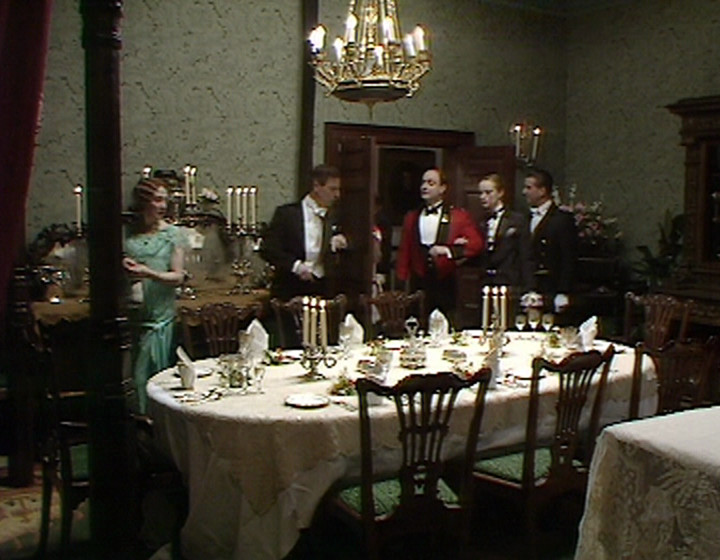
The obvious thing to do, then, is compare the sets in the pilot with those for Series 1.2 Firstly, that dining room set:

Pilot
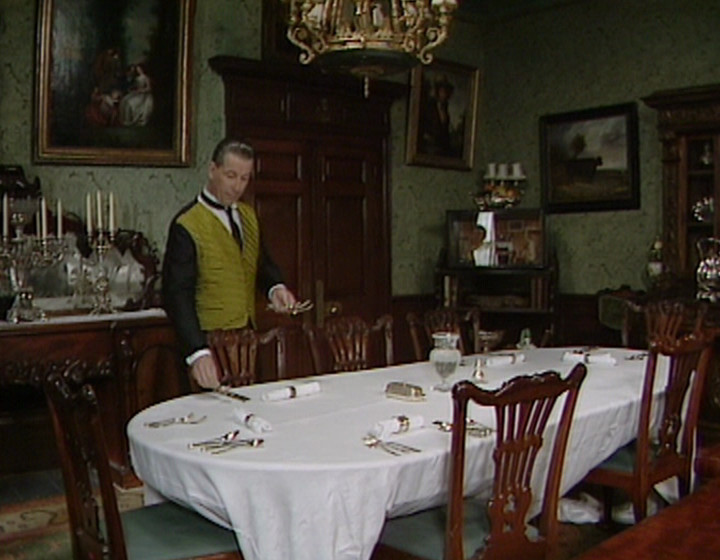
Fair Shares
Immediately, we can see that the oil paintings that should have been there for the pilot are now present. The door also has an extra piece of framing at the top; once you see it, the door in the pilot suddenly looks very incomplete and boxy.
Next, the hallway set:
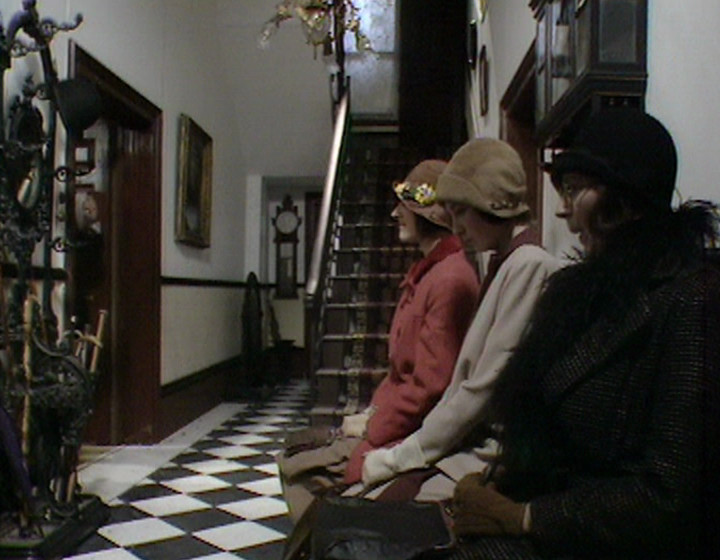
Pilot
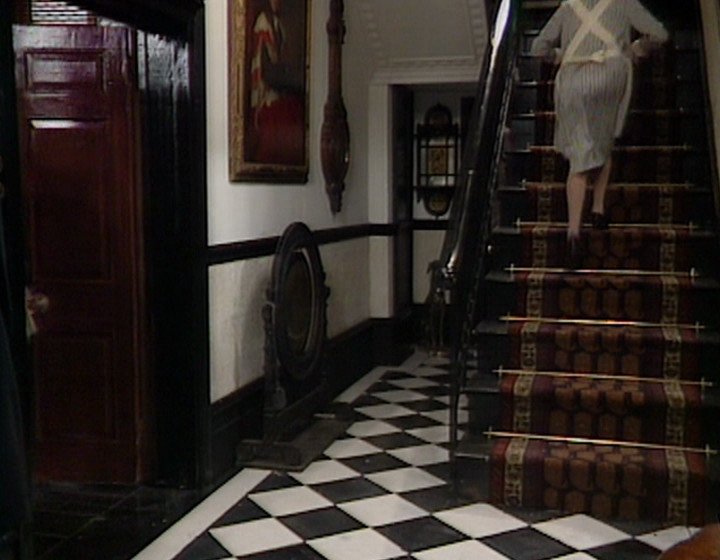
The Phantom Sign Writer
The change here isn’t quite as drastic as the dining room set; the walls are busier than the pilot, and the floor around the doorway has been painted with more detail. Most obviously, the wall at the top where the second flight of stairs has more decorative detail in the series; it’s awfully plain in the pilot.
Then we come to the drawing room:
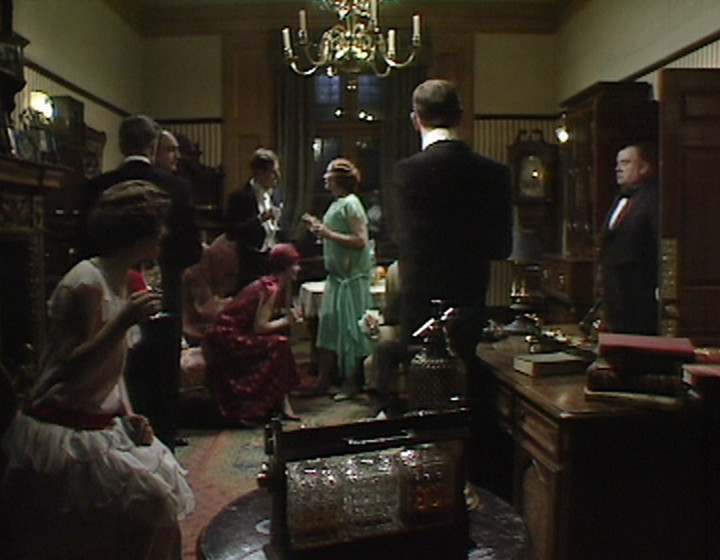
Pilot
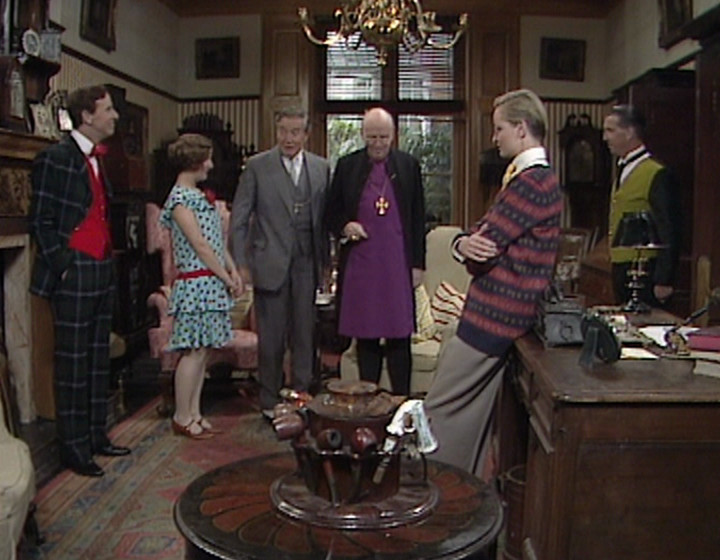
The Phantom Sign Writer
Again, the difference isn’t as drastic as with the dining room, but the empty spaces in the pilot where the pictures are supposed to be is very obvious when comparing the images side-by-side. The panelling at the back also looks distinctly unvarnished in the pilot.
Finally, the kitchen:

Pilot

A Deed of Gift
In many ways, this is the most obvious of them all, with the set in the pilot looking alarmingly incomplete in retrospect. Again, the panelling and the window frame look distinctly unvarnished, the curtains are missing, and that wall looks very bare without the utensils dressing. Even the water tank looks unfinished, with less texture to its surface, and the pipes missing.
And yet, the odd thing is… I didn’t notice a single thing wrong with the sets, when watching that pilot. The issue with the set dressing is only obvious when reading about it, and then directly comparing the sets to later in the series. If I hadn’t been told, I never would have known.
To be fair, no wonder Croft was annoyed. You Rang, M’Lord? is a sitcom which really is trying to have as much production value as possible. That pilot starts with a spectacularly staged battle sequence which you can’t quite believe was made for an audience sitcom. The show is 50 minutes long, has a huge cast, and seems to be deliberately pushing sitcom into brand new areas. The last thing Croft would want from this sumptuous production is for the set dressing to undermine it.
But then, I guess that’s what happens when your script is good, and the actors are putting in career-best performances. Your eyes don’t really stray to the walls.
Funny, that.

2 comments
Billy Smart on 27 May 2021 @ 10pm
Viewer blindness towards the set deficiencies is also helped by how much of the original audience will already know what these rooms *ought* to look like (from Upstairs, Downstairs and other programmes). The viewer will immediately register enough visual information from what dressing there is to work out, “that’s the dining room of a 1920s townhouse”, and can imaginatively fill in the missing paintings without even noticing that they aren’t actually there.
There’s a terrific article by Helen Wheatley about sets and properties (‘Rooms within Rooms: Upstairs Downstairs & the Studio Costume Drama of the 1970s’) in a book called ‘ITV Cultures’ that I would recommend to you.
John Hoare on 29 May 2021 @ 11am
Oooh, lovely, I will take a look. Thank you!
Comments on this post are now closed.